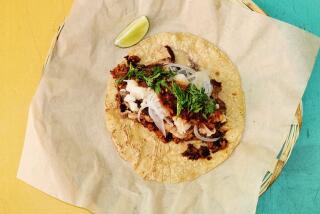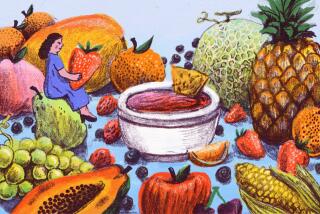The Essence of a Town Called Tequila : Finding the source of a drink that’s fiery and mellow
- Share via
TEQUILA — In the open courtyard beneath bougainvillea blossoms and strings of lights, a couple are dancing the jarabe tapatio, the traditional Mexican hat dance. The music picks up and the tall slim beauty in a colorful flaring dress whirls tight circles around the sombrero set on the ground.
Suddenly the music reaches a feverish climax. Someone rushes out and sets a bottle of tequila alongside the hat. Deftly, the dancer whirls around the bottle, her feet a blur. She finishes to waves of applause and shouts of “Bravo!” The bottle is opened and poured for all those at neighboring tables.
This is Guadalajara, birthplace of the charro (the Mexican cowboy) and the mariachi, and, above all, the capital of tequila country. Following the time-honored method, I sprinkle the back of my hand with a pinch of salt, raise my glass to my nose, inhale the pungent aroma hinting of mysterious spices, lick the salt off my hand, tilt the glass back with a bold gulp then suck a lime wedge plucked from a bowlful on the table.
The potent combination of salt, liquor and lime first shocks my mouth and throat with a 90 proof bite, then leaves a warm soothing aftertaste, a pleasing balance between tequila’s fire, the acidity of lime and the relief afforded by those grains of salt. “Salud!”
*
Immortalized in song and literature, tequila reflects the Mexican character and is as fiery as the chili-pepper-laced cuisine it complements. “Tequila is a perfect national liquor because it is mestizo--a mixture--just like the Mexican people themselves: part Indian, part Spanish,” says Jorge Berrueta Vallin, former Director General of Tequila Sauza, Mexico’s second biggest producer.
Tequila’s fame today belies its humble origins. As long as a millennium ago, Mexico’s Indians would suck the sap from the fleshy arms of a spiky desert plant called the agave. The sap would then be fermented into the mildly alcoholic brew pulque.
The Spanish invaders, however, turned up their noses at the beer-strength pulque, craving more potent aquardiente, or firewater. Bringing with them the secrets of distillation, the Spanish soon found the agave plant yielded a fairly clear liquor with a bite that became known as mescal, the potent forerunner of tequila. In 1910, when a “Tequila Wine” from Mexico garnered a trophy in San Antonio, Texas, the centuries-old conqueror’s brew had finally won its modern name.
Since I began visiting Mexico more than 20 years ago, I have had an interest in tequila, not just the rough varieties mixed into Margaritas, but some of the finer brews that, with age, take on some of the mellow characteristics of fine brandy. I was intrigued to learn that tequila is grown in only one region of the country--the boundaries are drawn by the government to ensure quality--and that it is produced from just one species of agave, which I always thought was a cactus, but is in fact a plant more closely related to the lily. “Tequila is a gift of the sun, we Mexicans like to say,” says Alejandro Angeles, a friend and fellow tequila aficionado from Mexico City, as we speed down a highway leading west out of Guadalajara. “Because the agave plant from which this liquid sunshine is harvested survives months of blistering desert heat each year without water.”
Angeles and I were headed to the very heart of tequila country--a small town 35 miles from Guadalajara that is actually called Tequila. We drove into the mile-high foothills of the Sierra Madre, past adobe farmhouses set in a landscape of dry brown grasses and rocky outcrops. On both sides of the road, and spreading toward small volcano cones that pock the treeless horizon, is a patchwork of blue-green, spiky agave plants. In his book, “The Old Patagonian Express,” Paul Theroux described them as “a field of upright swords.”
Only one of about 400 species of gave is used to make tequila, the blue agave. It grows well only in the dry highlands of the state of Jalisco and in small portions of four neighboring states. This extraordinary agave, which shimmers a brilliant blue green in intense sunlight, requires from eight to 10 years to reach maturity.
Angeles pulls up alongside a field where a worker, an obrero named Jose, sharpens his coa de jima, a long-handled tool with a round flat blade. After a few whacks he uproots a plant at its base and neatly slices off the spiky bayonet-like arms. Within moments all that remains is an egg-shaped core roughly the size of a large watermelon, weighing about 100 pounds and resembling a giant pineapple--or pin~a.
A few minutes later we reached Tequila, a whitewashed stucco town of 30,000 that resembles the set of a B-grade Western except for the tall brick smoke stacks of the 12 local distilleries. The biggest 10 produce three-quarters of the country’s tequila. Hand-painted advertisements for a variety of brands festoon the whitewashed houses.
“This is Tequila central,” says Angeles as we drive past a cluster of locals wearing Stetsons and cowboy boots. We enter the gates to La Perseverancia, the distillation plant where Don Cenobio Sauza produced his company’s first tequila in 1873. The Sauza distillery is set right in the village. In front is a quiet, palm-shaded hacienda with a splashing fountain and arched doorways sheltering cool walkways. Behind it is the sprawling modern distillery where a mural along one wall shows the tequila process from planting to distillation to a bacchanalian feast of food and drink.
At the loading bay of the Sauza distillery, workers empty a truck full of pin~as. From each load one pin~a is split and core samples are sent to the lab for sugar analysis. The pin~as are dumped into a hopper and sent toward a shredder that crushes them before they are slowly roasted in a huge oven for 12 to 14 hours. Alejandro hands me a dark brown chunk of cooked agave that smells and tastes delicious, somewhat like pumpkin sweetened with molasses.
The brown, syrupy aguamiel (honey water) extracted from the cooked agave is pumped into great stainless steel vats. At this point distillers are allowed to add up to 49% liquid sugar from cane or other sources; by law 51% of the final products’ sugar must come from the agave itself. After being allowed to ferment for 30 to 32 hours, yeasts consume all the sugars and convert them to alcohol. The alcohol content is now about 6.7%, similar to beer’s. The soupy liquid is then distilled twice to a pure high test 110 proof, which is called “young tequila.”
After four months in wooden or stainless steel vats, clear “white” tequila, the most popular style in Mexico, is ready for bottling at the company’s Guadalajara plant. To produce the “gold” tequila preferred by the export market, white tequila is blended with tequila aged briefly in wooden casks.
Next door to the Sauza plant is La Rojena, the distillery of the Jose Cuervo Co., Mexico’s oldest maker of tequila, established in 1795 by royal decree of Spanish King Charles IV. It is also by far the biggest in the country. In 1993, about 18 million gallons of tequila were produced in Mexico and the company’s trademark black crow--cuervo in Spanish--appeared on more than 6 million liters.
While sales of the regular white and gold tequilas have been losing ground in Mexico, a relatively new line of special premium tequilas has, over the last five years, become the fastest growing sector of sales at home and abroad--tequilas made up of 100% blue agave with no added sugars, then aged in wood.
The Herradura Tequila estate is a gracious old hacienda near the hamlet of Amatitan five miles from Tequila. It is a self-contained adobe-walled village with cobblestone streets where director Guillermo Romo is head of the family-owned company that since 1861 has produced only 100% agave tequilas.
“We have always felt it is a desecration to blend sugar with agave juice,” said Romo, 48, as he takes me through his distillery, one of the few still using some of the old tequila-making techniques. “In these 30-ton adobe and stone ovens, that are like those used a century or more ago, we cook halved pin~as because we feel the taste of the final product is better although the roasting takes 24 hours.” He shows me the original pits where mule-driven stone crushers shredded and extracted the juices from the cooked agave, and the old copper stills. “We used this equipment right up until 1962.”
What is aging in this cellar sweetly scented with a heady caramel aroma is an~ejo or aged tequila, which spends two years in white oak until it is golden brown with an oaky flavor that takes out all the sting and leaves a rich tequila taste. Other distillers also produce their own super smooth an~ejos.
Sauza’s Commemorativo was, in 1963, the first aged tequila to be released. Sauza’s Tres Generaciones and Cuervo’s 1800 are aged four years or more. These are super smooth tequilas that are becoming fashionable in upscale bars not only in Mexico but across the U.S. The Coyote Cafe in Santa Fe has 20 tequilas on its list; the Hyatt Regency in Chicago has 12.
These are sipping liquors, each with a nuance all its own, like a fine wine. No shooters allowed here; each drop is meant to be savored slowly from a snifter, whether it’s at the crowded Plaza in Guadalajara or in your own living room.
(BEGIN TEXT OF INFOBOX / INFOGRAPHIC)
GUIDEBOOK: A Toast to Margaritaville
Getting there: American, Mexicana, Delta and Aeromexico offer nonstop flights from LAX to Guadalajara; advance purchase tickets starting at $286 round trip.
If you want to rent a car, Avis, Hertz, Budget and National have offices at the Guadalajara airport and downtown. Take Route 15, a country highway that leads north of Guadalajara, to get to Tequila. Local buses leave every 20 minutes from the station on Calle Los Angeles. You also can book tours of tequila distilleries in most major hotels in Guadalajara.
The distilleries: Sauza, Cuervo and Herradura offer free tours of their distilleries and, of course, free samples and bottles of their full range of tequila at discount prices. Reservations required.
Tequila Cuervo, telephone 011-52-3-634-4170, fax 634-8893.
Tequila Sauza, tel. 011-52-3-679-0600, fax 679-0690.
Herradura, tel. 011-52-3-614-9657 or 658-4717, fax 614-0175.
Where to stay: Hotels in Tequila are pretty primitive; it’s better to stay in Guadalajara and make a day trip. Some choices are the Camino Real Hotel (Avenida Vallarta 5005; for reservations tel. [800] 7-CAMINO), $164-$222 per room, double occupancy; The Holiday Inn Crowne Plaza (Avenida Lopez Mateos Sur 2500; tel. [800] MEETING), $72-$76 per double room; Fiesta Americana Guadalajara (Aurelio Aceves 225; tel. [800] FIESTA1) $98-$173 per double.
Where to eat: There are a cluster of terrace style restaurants surrounding the main square of Tlaquepaque, the historic district of Guadalajara about three miles southeast of downtown. All serve a wide selection of tequilas with traditional meals. In addition: The Restaurant With No Name (80 Madero, Tlaquepaque; local tel. 635-4520; lunches and dinners from $13, a restaurant with excellent Mexican cuisine served on a lush tropical patio or in the art gallery interior; Aquellos Tiempos (Camino Real Hotel; tel. 121-8000; entrees $11 to $21), serving Mexican specialties that include gusanos de maguey (crispy fried cactus worms) as well as less challenging French cuisine. For more information: Jalisco State Office of Tourism, 102 Morelos, Plaza Tapatia; tel. 011-52-3-658-2222. Or the Mexican Government Tourism Office, 1801 Century Park East, Suite 1080, Century City, 90067; (310) 203-8191, fax (310) 203-8316.
--M.P.
More to Read
Eat your way across L.A.
Get our weekly Tasting Notes newsletter for reviews, news and more.
You may occasionally receive promotional content from the Los Angeles Times.









